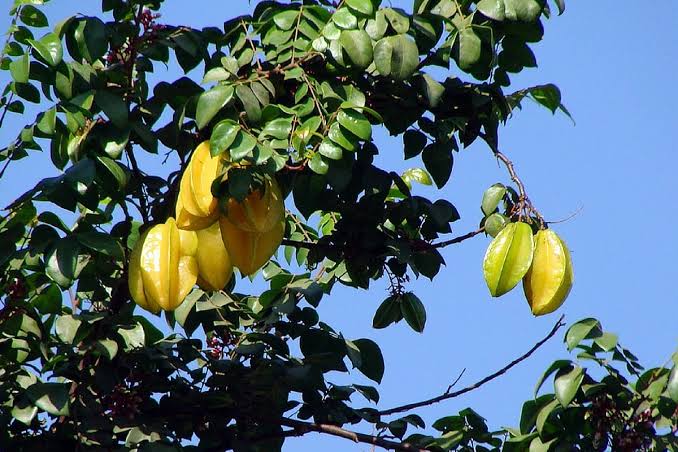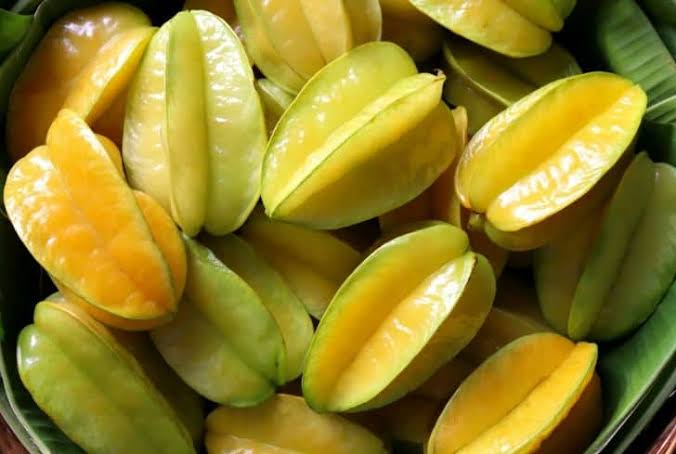Star fruit, scientifically known as Averrhoa carambola, is a delightful tropical fruit that captivates both the eyes and taste buds. Its unique name originates from the distinctive shape it possesses when sliced, resembling a star. This fruit is native to Southeast Asia but has found its way to various tropical regions worldwide.
Star fruits come in various colors, ranging from green to yellow, depending on their ripeness. Their skin is smooth and waxy, encasing a juicy, translucent flesh that is both sweet and tangy. The flavor profile is a delightful blend of citrus and apple, making it a refreshing treat for those seeking a tropical culinary experience.
One of the remarkable features of star fruit is its versatility. It can be enjoyed fresh, sliced into star-shaped pieces that add a decorative touch to salads and fruit bowls. The vibrant flavor of star fruit also makes it a popular ingredient in juices, smoothies, and desserts. Its ability to complement both sweet and savory dishes makes it a favorite among chefs exploring diverse culinary creations.
Beyond its delicious taste, star fruit brings nutritional benefits to the table. It is a rich source of vitamin C, providing a boost to the immune system. The fruit also contains dietary fiber, aiding in digestion and promoting a healthy gut. With its low calorie and high water content, star fruit is an excellent choice for those looking to maintain a balanced and hydrating diet.
In addition to its culinary and nutritional merits, star fruit has been used in traditional medicine for various purposes. Some cultures believe it possesses anti-inflammatory properties, while others value its potential to alleviate skin conditions. It’s essential to note that, like any food, individual reactions may vary, and moderation is key.
Cultivating star fruit requires a tropical or subtropical climate, where it thrives in well-drained soil and ample sunlight. The tree itself is an evergreen, adorned with small, lilac-colored flowers that precede the fruit. Its adaptability to different soil types and resistance to pests contribute to its popularity among farmers and home gardeners in suitable regions.
In addition, star fruit, scientifically known as Averrhoa carambola, is a tropical delight cherished for its appealing appearance, versatile flavor, and nutritional value. Whether enjoyed fresh, in beverages, or incorporated into various dishes, this fruit has carved a special place in the hearts of those seeking a taste of the tropics.
Read Also: Principles of Feeding Rabbit and Feed Resources
The History of Star Fruits

The history of star fruit (Averrhoa carambola) traces its roots back to Southeast Asia, where it is believed to have originated. The fruit has a longstanding presence in the region’s culinary and cultural heritage, with its cultivation dating back centuries.
Originally native to countries such as India, Sri Lanka, Indonesia, and Malaysia, star fruit found its way to other tropical regions through trade and exploration. Its appealing taste and unique star-shaped appearance made it a prized commodity among traders and explorers, contributing to its spread to places like the Caribbean, South America, and parts of Africa.
The cultivation and consumption of star fruit became integral to the traditions and diets of various cultures. Its adaptability to tropical climates allowed it to flourish in regions with warm temperatures and abundant sunlight. Over time, different varieties of star fruit emerged, each with its own subtle variations in flavor, size, and color.
Star fruit’s journey from its native lands to new territories introduced it to diverse culinary landscapes. As it became more widely available, the fruit became a symbol of exoticism and a sought-after addition to both local and international cuisines.
In addition to its culinary significance, star fruit has found a place in traditional medicine in some cultures. Historical records suggest that various parts of the plant were used for medicinal purposes, ranging from treating skin conditions to addressing digestive issues. While modern scientific research continues to explore the potential health benefits of star fruit, these historical uses highlight the plant’s multifaceted role in societies throughout the ages.
Today, star fruit stands as a global ambassador of tropical flavors, enjoyed by people around the world. Its journey through history reflects not only its botanical characteristics but also its cultural impact, shaping the way different communities appreciate and incorporate this distinctive fruit into their daily lives.
The Nutritional Values of Star Fruits

Star fruit, scientifically known as Averrhoa carambola, boasts a range of nutritional values that contribute to its appeal as a healthful and delicious addition to diets. Here’s a breakdown of its nutritional components:
1. Vitamin C: Star fruit is rich in vitamin C, an essential antioxidant that supports the immune system, promotes skin health, and aids in the absorption of iron.
2. Dietary Fiber: The fruit contains dietary fiber, which is beneficial for digestive health. Fiber helps prevent constipation, promotes regular bowel movements, and supports a healthy gut.
3. Low Calorie Content: For those mindful of calorie intake, star fruit is a favorable option. It provides a sweet and flavorful experience without a high caloric load, making it suitable for various dietary plans.
4. Hydration: With its high water content, star fruit contributes to hydration, helping maintain fluid balance in the body. This is particularly beneficial in tropical climates where dehydration can be a concern.
5. Phytonutrients: Star fruit contains phytonutrients, which are natural compounds with potential health benefits. These compounds contribute to the fruit’s vibrant color and may have antioxidant properties.
6. Minerals: Star fruit contains minerals like potassium, which plays a crucial role in maintaining proper heart and muscle function, and copper, important for the formation of red blood cells.
It’s important to note that while star fruit offers these nutritional benefits, individuals with kidney issues should exercise caution. The fruit contains oxalates, which, when consumed in excess, may be problematic for those with kidney disorders.
As with any food, moderation is key. Including star fruit as part of a balanced diet can contribute to overall well-being and provide a tasty and nutritious alternative to other fruits.
Read Also: Nine (9) Nutrient Requirements of Rabbits
Health Benefits of Star Fruits

Star fruit, scientifically known as Averrhoa carambola, offers several health benefits, making it a valuable addition to a balanced diet. Here are some of the potential health benefits associated with consuming star fruit:
1. Rich in Antioxidants: Star fruit contains antioxidants, including vitamin C and phytonutrients, which help neutralize free radicals in the body. This may contribute to reducing oxidative stress and lowering the risk of chronic diseases.
2. Supports Immune Function: The high vitamin C content in star fruit plays a vital role in supporting the immune system. Adequate vitamin C intake is associated with a lower susceptibility to infections and a faster recovery from illnesses.
3. Aids Digestive Health: The dietary fiber in star fruit promotes healthy digestion. Fiber helps prevent constipation, supports regular bowel movements, and contributes to overall gut health.
4. Hydration: With its high water content, star fruit helps keep the body hydrated. Proper hydration is essential for various bodily functions, including temperature regulation and nutrient transportation.
5. Heart Health: Star fruit contains potassium, a mineral associated with maintaining healthy blood pressure levels. Including potassium-rich foods in the diet, such as star fruit, may contribute to cardiovascular health.
6. Low in Calories: For those managing weight or calorie intake, star fruit is a low-calorie option that provides sweetness and flavor without a high caloric load.
7. Potential Anti-Inflammatory Properties: Some studies suggest that star fruit may possess anti-inflammatory properties, which could be beneficial in reducing inflammation in the body.
8. Skin Health: The combination of antioxidants and vitamin C in star fruit may contribute to healthy skin by protecting against oxidative damage and supporting collagen production.
It’s crucial to note that individual responses to foods can vary, and excessive consumption of star fruit may not be suitable for individuals with kidney issues due to its oxalate content. As with any dietary change, it’s advisable to consult with a healthcare professional, especially if there are pre-existing health conditions or concerns. Incorporating star fruit as part of a diverse and balanced diet can contribute to overall well-being.
How to Grow Star Fruits
Growing star fruit, scientifically known as Averrhoa carambola, requires attention to specific conditions to ensure a thriving and fruitful tree. Here’s a general guide on how to grow star fruit:
1. Climate: Star fruit thrives in tropical and subtropical climates. It requires warm temperatures and is sensitive to frost. Ideally, temperatures should not drop below 32°F (0°C). In regions with cooler climates, consider planting star fruit in containers that can be moved indoors during colder seasons.
2. Soil: Choose well-draining soil with a slightly acidic to neutral pH. Sandy loam or loamy soil types are suitable. Good drainage is crucial to prevent waterlogging, which can be detrimental to the roots.
3. Sunlight: Star fruit trees love sunlight. Plant them in a location where they can receive full sun exposure for at least 6 to 8 hours a day. This promotes healthy growth and fruit production.
4. Watering: While star fruit is relatively drought-tolerant once established, it benefits from consistent moisture, especially during dry periods. Water the tree regularly, allowing the soil to dry out slightly between waterings. Avoid overwatering, as this can lead to root rot.
5. Fertilization: Fertilize the tree regularly with a balanced, slow-release fertilizer. Apply fertilizer in the growing season, typically spring and summer. Follow the recommended dosage on the fertilizer package, as excessive fertilization can harm the tree.
6. Pruning: Prune the tree to maintain its shape and encourage proper airflow. Remove dead or diseased branches and any crowded growth. Pruning helps prevent pest infestations and enhances fruit production.
7. Pollination: Star fruit trees are primarily self-pollinating, but some varieties benefit from cross-pollination. In areas with limited pollinators, hand-pollination can be done by transferring pollen between flowers using a small brush.
8. Harvesting: Star fruit trees usually start bearing fruit within 2 to 4 years of planting. Harvest the fruit when it reaches full color and is slightly firm. The fruit continues to ripen after picking, so it’s best to harvest just before full maturity.
9. Pests and Diseases: Keep an eye out for common pests like aphids and scale insects. Regular inspection helps detect issues early. Treat pest problems with natural remedies or insecticidal soaps. Proper sanitation and good cultural practices can prevent many diseases.
10. Container Growing: In cooler climates or limited space, consider growing star fruit in containers. Use a well-draining potting mix and provide adequate sunlight. Containers should have drainage holes, and the tree may need protection from frost during colder seasons.
Read Also: Top 20 Key Principles Of Best Fitness
